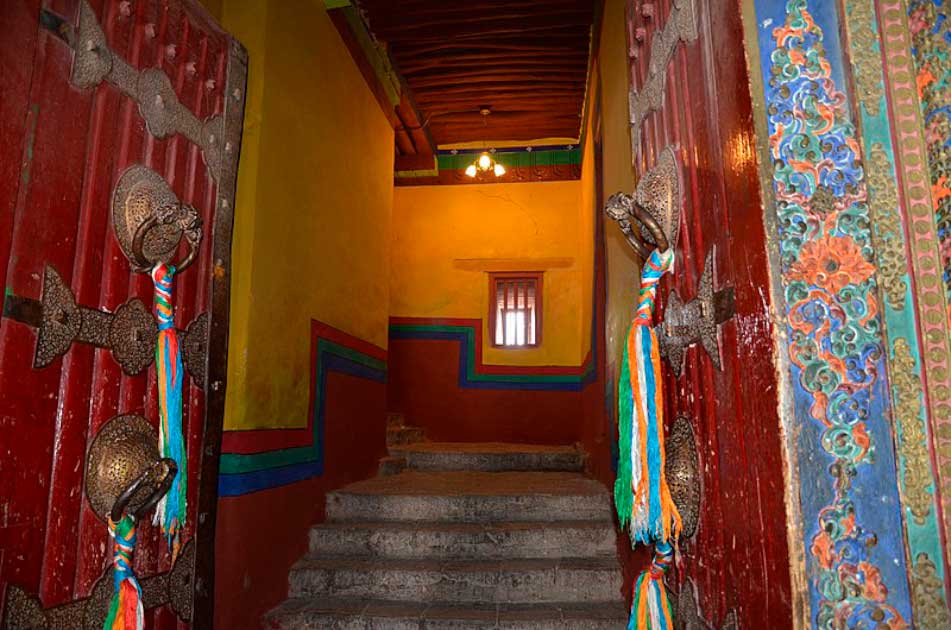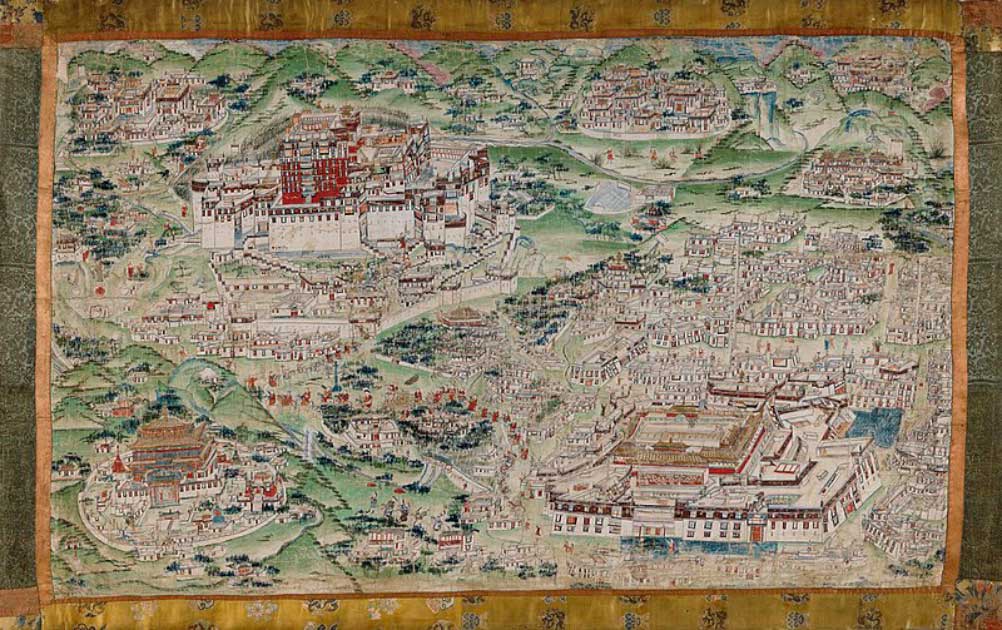The Potala Palace is a remarkable architectural marvel and an important religious and cultural site found in Lhasa, the capital city of Tibet. The palace is perched on a hill overlooking the city, and its striking white and red façade, intricate carvings, and golden roofs are a testament to the skill and creativity of the craftsmen who built it.
The Potala Palace has a rich history, and many legends and stories are associated with it. Today, it is a UNESCO World Heritage site and a popular tourist destination, attracting visitors from all over the world who come to admire its beauty and learn about its cultural significance.
What is the Potala Palace?
The Potala Palace, located in Lhasa, Tibet is a type of fortified Tibetan monastery known as a dzong fortress. Construction began in 1645 and it served as the winter palace for the Dalai Lamas from 1649 until 1959 when it became a museum.
The palace takes its name after Mount Potalaka which in Buddhist mythology was home to the bodhisattva Avalokitesvara, an important deity in Tibetan Buddhism. Construction began on the complex after the 5th Dalai Lama was told by his spiritual advisor that the site would make an ideal seat of government.
The building itself is incredibly impressive and truly massive. It measures 400 meters (1300 feet) from east to west and 350 meters (1150 feet) from north to south. It has sloping stone walls that average around 3 meters (9.8 feet) thick with copper-reinforced foundations to protect against earthquakes.
The 13 floors of the building feature over 1,000 rooms, 10,000 shrines, and at least 200,000 statues. The corridors and passageways are said to wind deep into the mountain, and there are many secrets hidden in its depths.
A Trove of Treasures
The Potala Palace is a treasure trove of historical and religious artifacts. Its interior walls host over 2,500 square meters of murals. These murals depict historical figures, historical stories, Buddhist scriptures, myths, folk customs, and pretty much every facet of Tibetan culture. Perhaps the palace’s most famous mural is the wedding scene of Princess Wencheng, and the Tibetan King Songsten Gampo.

Other artworks include the Thangkas, a type of Tibetan scroll painting. These stunning pieces, which are painted on silk, cloth, or paper usually depict Buddha incarnations, Bodhisattvas, and Tibetan Buddhist masters as well as religious customs. The palace is home to more than 10,000 of these masterpieces.
The Palace also houses a vast number of sculptures and statues, many of which date back to the 7th century. These include stone, wood, and clay carvings. The most impressive of these statues is probably the cast-iron Buddha statue, the largest of which can be over 10 meters (33 feet) in height while the smallest are incredibly intricate and are only a few centimeters or inches tall.
Alongside these artworks are eight incredible Stupas (Buddhist shrines), each of which houses the body of a Dalai Lama. These stupas vary in size but are all grand in scale.
Built from wood, they are decorated with gold and precious jewels. The most extravagant of the 8 is the fifth Dalai Lama’s stupa which is 15 meters (50ft) tall and wrapped in gold. Richly decorated, it is adorned with over 15,000 jewels including diamonds, rubies, and emeralds.
Perhaps the most precious items held within the Potala Palace however are the 40,000 volumes of antique texts. These texts, which are written in Mandarin, Tibetan, Manchu, Mongolian, and Sanskrit are predominantly focused on the Buddhist religious scriptures.
The rarest and most precious of which is the Tibetan Kagyur of the Tripitaka. This was written ink made from gold, silver, coral, iron, green diamond, red copper, white conch shell, and pearl powder.
A Palace Fashioned in Red and White
But it isn’t just the contents of the of the treasure rooms which amaze, and in truth the Potala Palace isn’t just one structure. Within its outer walls are the Red and White Palaces as well as the palace gardens, known as the Shol Village. The two individual palaces had distinct functions. The White Palace was the winter residence of ten successive Dalai Lamas and their courts.
It also housed the former offices of the Tibetan government and featured government assembly halls and other official offices. It was completed in 1649 by the fifth Dalai Lama.

The Red palace is located at the center of the Potala Palace complex. It was a later addition and was built in 1690 by the 6th Dalai Lama. The Palace is surrounded by golden roofs of gilded bronze. These are the roofs of the earlier-mentioned holy stupas of the Dalai Lamas.
The Red palace was mainly a house of prayer for the Dalai lamas. It was dedicated to the study of Buddhism and the advancement of the Buddhist religion.
Unsurprisingly the Potala Palace has its fair share of myths and legends. According to legend Potala Palace was built on the site of a sacred cave where the bodhisattva Avalokiteshvara once meditated, granting the land and the palace upon it special powers.
- Shambhala: The Doomed Russian Expedition into the Hollow Earth
- Hundreds of Skeletons at Roopkund Lake of the Himalayas
It is also said that the palace has many secret tunnels and chambers that connect it to other important buildings in the region, such as the Norbulingka Summer Palace. It was said that these tunnels were originally used by the various Dalai Lamas and their entourages to escape in times of danger. Today many believe they are used to hide away untold riches.
One of these hidden treasures is supposedly the “Life-Sustaining Pillar”, a large wooden column that is said to contain the essence of the Buddha. Some believe this pillar has protected the palace from earthquakes over the centuries.
With all the mysticism connected to Potala Palace, it should come as no surprise that it also has its fair share of ghost stories. It is said that the palace is haunted by the spirit of a former monk who was killed during a revolt against the Qing dynasty during the 18th century. Many people have claimed to have seen his ghost wandering the halls of the palace at night.
If this isn’t creepy enough it’s also said that the Red Palace is haunted. Some believe that this section of the palace is haunted by the ghosts of past Dalai Lamas and visitors claim to have heard eerie chanting and have seen flickering lights coming from the Red Palace at night.
Sadly, not all the tales of Potala Palace are as fantastical in nature and the site has frequently seen the darker side of history. It is said that when the 5th Dalai Lama began construction of the palace in 1645 he did so using forced labor with the help of Mongolian and Chinese artisans. Supposedly the laborers were worked so hard that when the palace was finally completed they had to be carried down the mountain on stretchers.

During the Cultural Revolution in China, many of the palace’s treasures and artifacts were destroyed or looted and the Dalai Lama was forced to flee into exile in India. Today the palace has been partially restored to its former glory and serves as a symbol of Tibetan culture and resistance to Chinese rule.
Conclusion
The Potala Palace is not only a magnificent architectural wonder but also a symbol of Tibet’s rich cultural and spiritual heritage. It is a place where legends and history intertwine, with stories of ghosts, hidden treasures, secret tunnels, and political upheavals.
Despite the challenges it has faced over the centuries, the palace remains a testament to the resilience and endurance of the Tibetan people, who continue to revere it as a sacred site and cultural icon. The Potala Palace’s complex history and cultural significance make it a fascinating destination for tourists and scholars alike, and it will undoubtedly continue to captivate and inspire generations to come.
Top Image: The enormous Potala Palace. Source: piboon / Adobe Stock.